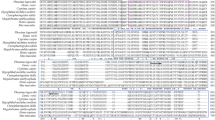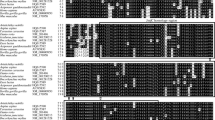Abstract
Hypoxia-inducible factors (HIFs) are master transcription factor regulating hypoxic responses in vertebrates. Species of Schizothoracine, a sub-family of cyprinidae, are highly endemic to the hypoxic Qinghai-Tibetan Plateau (QTP). What roles the HIFs play in hypoxic adaptation in the Schizothoracine fish is little known. In this study, the HIF-1α/B gene from Gymnocypris dobula (Gd) was characterized. The predicted protein for Gd-HIF-1α/B contains the main domains (bHLH, PAS, PAC, ODD, N-TAD, and C-TAD). Moreover, a specific mutation that the proline hydroxylation motif (LXXLAP) mutated into PxxLAP was observed in Gd-HIF-1α/B CODD domain, which may lead to changes in the function. To clarify whether HIF-1α/B of G. dobula possesses hypoxic adaptive features, Gd-HIF1α/B and Schizothorax prenanti-HIF1α/B (Sp-HIF1α/B) were cloned into an expression vector and transfected into 293T cells. Cell viability was found to be significantly higher in cells transfected with Gd-HIF-1α/B than those transfected with Sp-HIF-1α/B under hypoxic conditions. In addition, G. dobula HIF-1α/B showed stronger activity in transactivating the expression of nitric oxide (NO)–synthesizing enzyme, NOS2B under hypoxia stresses than the orthologous gene from S. prenanti, which were accompanied with upregulated expressions of NOS2B in heart of G. dobula, which may attribute to elevated NO levels detected in G. dobula than the lower land species. These results indicated that the HIF-1α plays an important role in mediating the iNOS signaling system in the process of evolutionary adaptation of the Schizothoracine to the highland environment.




Similar content being viewed by others
References
Barroso JB, Carreras A, Esteban FJ, Peinado MA, Martínez-Lara E, Valderrama R, Jiménez A, Rodrigo J, Lupiáñez JA (2000) Molecular and kinetic characterization and cell type location of inducible nitric oxide synthase in fish. Am J Phys Regul Integr Comp Phys 279:R650–R656
Cao WX, Chen YY, Wu YF, Zhu SQ (1981) Origin and evolution of Schizothorscine fish in relation to the upheaval of the Qinghai-Xizang Plateau, studies on the period. Amplitude and Type of the Uplift of the Qinghai-Xizang Plateau 118–130
Chan JL, Li WW, Hu XX, Liu Y, Xu QH (2016) Genetic diversity and population structure analysis of Qinghai-Tibetan Plateau schizothoracine fish (Gymnocypris dobula) based on mtDNA D-loop sequences. Biochem Syst Ecol 69:152–160
Chen N, Chen LP, Zhang J, Chen C, Wei XL, Gul Y, Wang WM, Wang HL (2012) Molecular characterization and expression analysis of three hypoxia-inducible factor alpha subunits, HIF-1α/2α/3α of the hypoxia-sensitive freshwater species, Chinese sucker. Gene 498:81–90
Chi W, Gan XN, Xiao WH, Wang W, He SP (2013) Different evolutionary patterns of hypoxia-inducible factor α (HIF-α) isoforms in the basal branches of Actinopterygii and Sarcopterygii. FEBS Open Bio 3:479–483
Erzurum S, Ghosh S, Janocha A, Xu W, Bauer S, Bryan N, Tejero J, Hemann C, Hille R, Stuehr D (2007) Higher blood flow and circulating NO products offset high-altitude hypoxia among Tibetans. Proc Natl Acad Sci 104:17593–17598
Espey MG, Thomas DD, Miranda KM, Wink DA (2002) Focusing of nitric oxide mediated nitrosation and oxidative nitrosylation as a consequence of reaction with superoxide. Proc Natl Acad Sci 99:11127–11132
Frisancho AR (2013) Developmental functional adaptation to high altitude: review. Am J Hum Biol 25:151–168
Gonzalez-Domenech C, Munoz-Chapuli R (2010) Molecular evolution of nitric oxide synthases in metazoans. Comp Biochem Physiol Part D Genomics Proteomics 5:295–301
Guan LH, Chi WH, Xiao W, Chen LB, He SP (2014) Analysis of hypoxia-inducible factor alpha polyploidization reveals adaptation to Tibetan Plateau in the evolution of schizothoracine fish. BMC Evol Biol 14:192
Kwasek K, Rimoldi S, Cattaneo AG, Parker T, Dabrowski K, Terova G (2017) The expression of hypoxia-inducible factor-1α gene is not affected by low-oxygen conditions in yellow perch (Perca flavescens) juveniles. Fish Physiol Biochem 43:849–862
Law SHW, Wu RSS, Ng PKS, Yu RMK, Kong RYC (2006) Cloning and expression analysis of two distinct HIF-alpha isoforms– gcHIF-1alpha and gcHIF-4alpha – from the hypoxia-tolerant grass carp, Ctenopharyngodon idellus. BMC Mol Biol 7:15
Li Y, Ren Z, Shedlock AM, Wu J, Sang L, Tersing T, Hasegawa M, Yonezawa T, Zhong Y (2013) High altitude adaptation of the schizothoracine fish (Cyprinidae) revealed by the mitochondrial genome analyses. Gene 517:169–178
Li XC, Liu XS, Xu YJ, Liu J, Xie M, Ni W, Chen SX (2014) KLF5 promotes hypoxia-induced survival and inhibits apoptosis in non-small cell lung cancer cells via HIF-1α. Int J Oncol 45:1507–1514
Masson N, Willam C, Maxwell PH, Pugh CW, Ratcliffe PJ (2001) Independent function of two destruction domains in hypoxia-inducible factor-alpha chains activated by prolyl hydroxylation. EMBO J 20:5197–5206
Maxwell PH, Wiesener MS, Chang GW, Clifford SC, Vaux EC, Cockman ME, Wykoff CC, Pugh CW, Maher ER, Ratcliffe PJ (1999) The tumour suppressor protein VHL targets hypoxia-inducible factors for oxygen-dependent proteolysis. Nature 399:271–275
Mizokami K, Kakeji Y, Oda S, Irie K, Yonemura T, Konishi F, Maehara Y (2006) Clinicopathologic significance of hypoxia-inducible factor 1α overexpression in gastric carcinomas. J Surg Oncol 94:149–154
Petousi N, Croft QP, Cavalleri GL, Cheng HY, Formenti F, Ishida K, Lunn D, McCormack M, Shianna KV, Talbot NP (2014) Tibetans living at sea level have a hyporesponsive hypoxia-inducible factor system and blunted physiological responses to hypoxia. J Appl Physiol 116:893–904
Qi DL, Chao Y, Guo SC, Zhao LY, Li TP, Wei FL, Zhao XQ (2012) Convergent, parallel and correlated evolution of trophic morphologies in the subfamily schizothoracinae from the Qinghai-Tibetan Plateau. PLoS One 7:e34070
Rahman MS, Thomas P (2007) Molecular cloning, characterization and expression of two hypoxia inducible factor alpha subunits, HIF-1α and HIF-2α, in a hypoxia-tolerant marine teleost, Atlantic croaker (Micropogonias undulatus). Gene 396:273–282
Rimoldi S, Terova G, Ceccuzzi P, Marelli S, Antonini M, Saroglia M (2016) HIF-1a mRNA levels in Eurasian perch (Perca fluviatilis) exposed to acute and chronic hypoxia. Mol Biol Rep 39:4009–4015
Rytkönen KT, Vuori KA, Primmer CR, Nikinmaa M (2007) Comparison of hypoxia-inducible factor-1 alpha in hypoxia-sensitive and hypoxia-tolerant fish species. Comp Biochem Physiol Part D Genomics Proteomics 2:177–186
Rytkönen KT, Akbarzadeh A, Miandare HK, Kamei H, Duan C, Leder EH, Williams TA, Nikinmaa M (2013) Subfunctionalization of cyprinid hypoxia-inducible factors for roles in development and oxygen sensing. Evolution 67:873–882
Semenza GL (1998) Hypoxia-inducible factor 1: master regulator of O2 homeostasis. Curr Opin Genet Dev 8:588–594
Semenza GL (2001) Hypoxia-inducible factor 1: oxygen homeostasis and disease pathophysiology. Trends Mol Med 7:345–350
Soitamo AJ, Rabergh CMI, Gassmann M, Sistonene L, Nikinmaa M (2001) Characterization of a hypoxia-inducible factor (HIF-1α) from rainbow trout. J Biol Chem 276:19699–19705
Sollid J, Rissanen E, Tranberg HK, Thorstensen T, Vuori KAM, Nikinmaa M, Nilsson GE (2006) HIF-1a and iNOS levels in crucian carp gills during hypoxia-induced transformation. J Comp Physiol B 176:359–369
Sowter HM, Ratcliffe PJ, Watson P, Greenberg AH, Harris AL (2001) HIF-1-dependent regulation of hypoxic induction of the cell death factors BNIP3 and NIX in human tumors. Cancer Res 61:6669–6673
Talks KL, Turley H, Gatter KC, Maxwell PH, Pugh CW, Ratcliffe PJ, Harris AL (2000) The expression and distribution of the hypoxia-inducible factors HIF-1α and HIF-2α in normal human tissues, cancers, and tumor-associated macrophages. Am J Pathol 157:411–421
Terova G, Rimoldi S, Corà S, Bernardini G, Gornati R, Saroglia M (2008) Acute and chronic hypoxia affects HIF-1a levels in sea bass (Dicentrarchus labrax). Aquaculture 279:150–159
Thompson L, Dong Y, Evans L (2009) Chronic hypoxia increases inducible NOS-derived nitric oxide in fetal Guinea pig hearts. Pediatr Res 65:188–192
Trajanovska S, Donald JA (2011) Endothelial nitric oxide synthase in the amphibian, Xenopus tropicalis. Comp Biochem Physiol B: Biochem Mol Biol 158:274–281
Wang XO, Ma S, Qi GX (2012) Effect of hypoxia-inducible factor 1-alpha on hypoxia/reoxygenation-induced apoptosis in primary neonatal rat cardiomyocytes. Biochem Biophys Res Commun 417:1227–1234
Wenger RH (2002) Cellular adaptation to hypoxia: O2-sensing protein hydroxylases, hypoxia-inducible transcription factors, and O2-regulated gene expression. FASEB J 16:1151–1162
Xu QH, Cai C, Hu XX, Liu Y, Guo YN, Hu P, Chen ZZ, Peng SH, Zhang DS, Jiang SW, Wu ZC, Chan JL, Chen LB (2015) Evolutionary suppression of erythropoiesis via the modulation of TGF-β signaling in an Antarctic icefish. Mol Ecol 24:4664–4678
Xu QH, Zhang C, Zhang DS, Jiang HP, Peng SH, Liu Y, Zhao K, Wang CC, Chen LB (2016) Analysis of the erythropoietin of a Tibetan Plateau schizothoracine fish (Gymnocypris dobula) reveals enhanced cytoprotection function in hypoxic environments. BMC Evol Biol 16:11
Yu MC, Zhang DS, Hu P, Peng SH, Li WW, He SP, Xu QH, Chen LB (2017) Divergent adaptation to Qinghai-Tibetan Plateau implicated from transciptome study of Gymnocypris dobula and Schizothorax nukiangensis. Biochem Syst Ecol 71:97–105
Zhang DS, Yu MC, Hu P, Peng SH, Liu YM, Li WW, Wang CC, He SP, Zhai WY, Xu QH, Chen LB (2017) Genetic adaptation of the Schizothoracine fish to the phased uplifting of Qinghai-Tibetan Plateau. G3: Gene Genetics Genomics 7:1267–1276
Acknowledgments
We would like to thank all of the people in the Yadong Forestry Bureau, Tibet, for the sample collection.
Funding
This work was supported in part by the Research Project of the Chinese Ministry of Education (no. 213013A), the National Natural Science Foundation of China (grant no. 31772826), the National Natural Science Foundation of China (grant no. 31572598), the National Natural Science Foundation of China (grant no. 31572611), and the National Natural Science Foundation of China (grant no. 31702312).
Author information
Authors and Affiliations
Corresponding authors
Ethics declarations
Experimental protocols involving live animals were approved by the Ethics Committee for the Use of Animal Subjects of Shanghai Ocean University.
Conflict of interest
The authors declare that they have no conflict of interest.
Additional information
Publisher’s note
Springer Nature remains neutral with regard to jurisdictional claims in published maps and institutional affiliations.
Congcong Wang and Xiaohu Wu are co-first authors.
Rights and permissions
About this article
Cite this article
Wang, C., Wu, X., Hu, X. et al. Hypoxia-inducible factor 1α from a high-altitude fish enhances cytoprotection and elevates nitric oxide production in hypoxic environment. Fish Physiol Biochem 46, 39–49 (2020). https://doi.org/10.1007/s10695-019-00694-7
Received:
Accepted:
Published:
Issue Date:
DOI: https://doi.org/10.1007/s10695-019-00694-7




